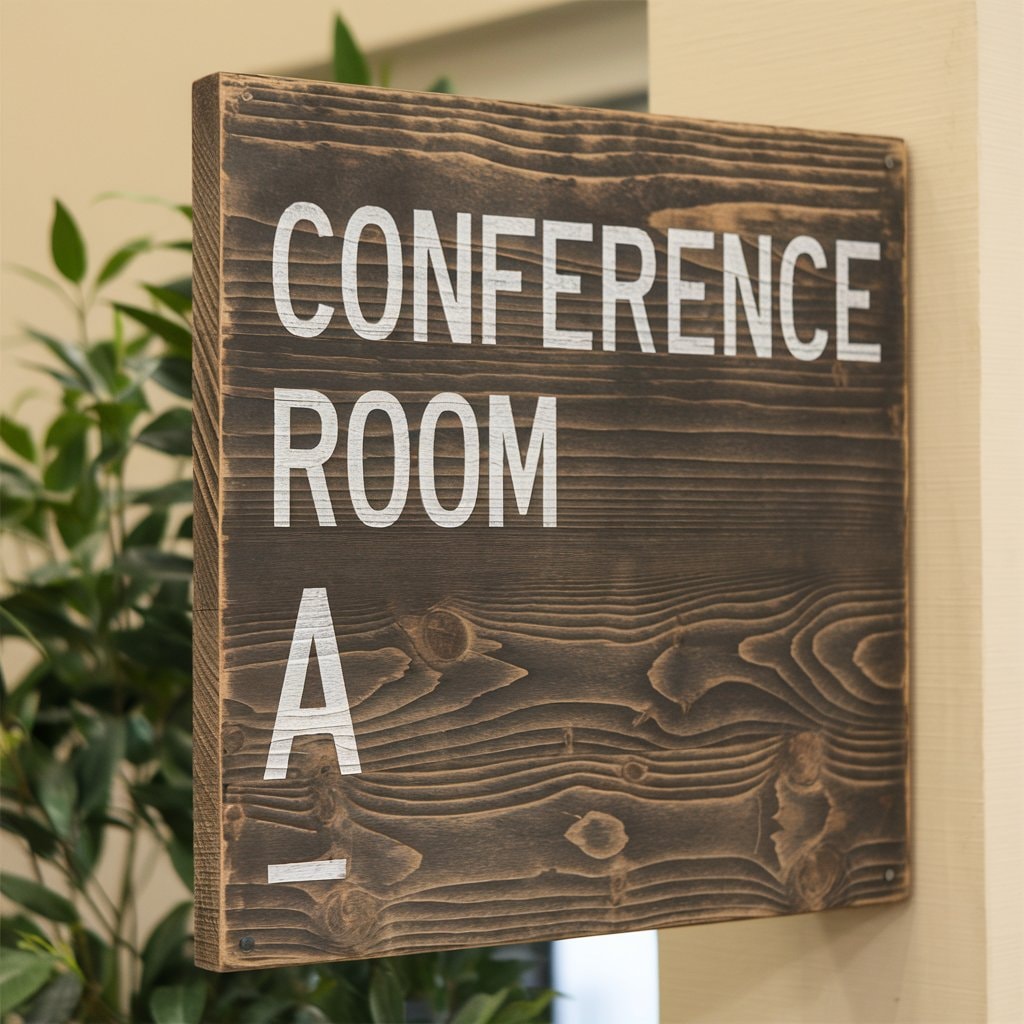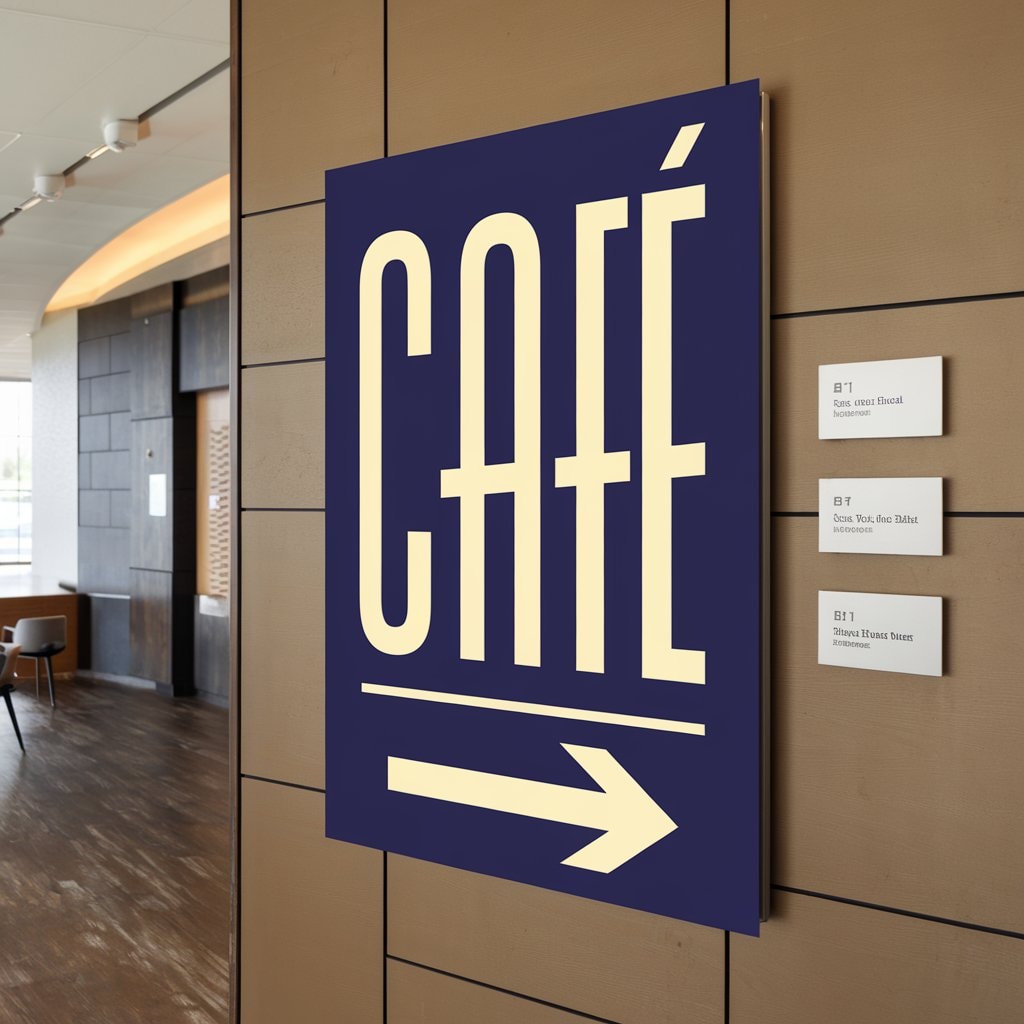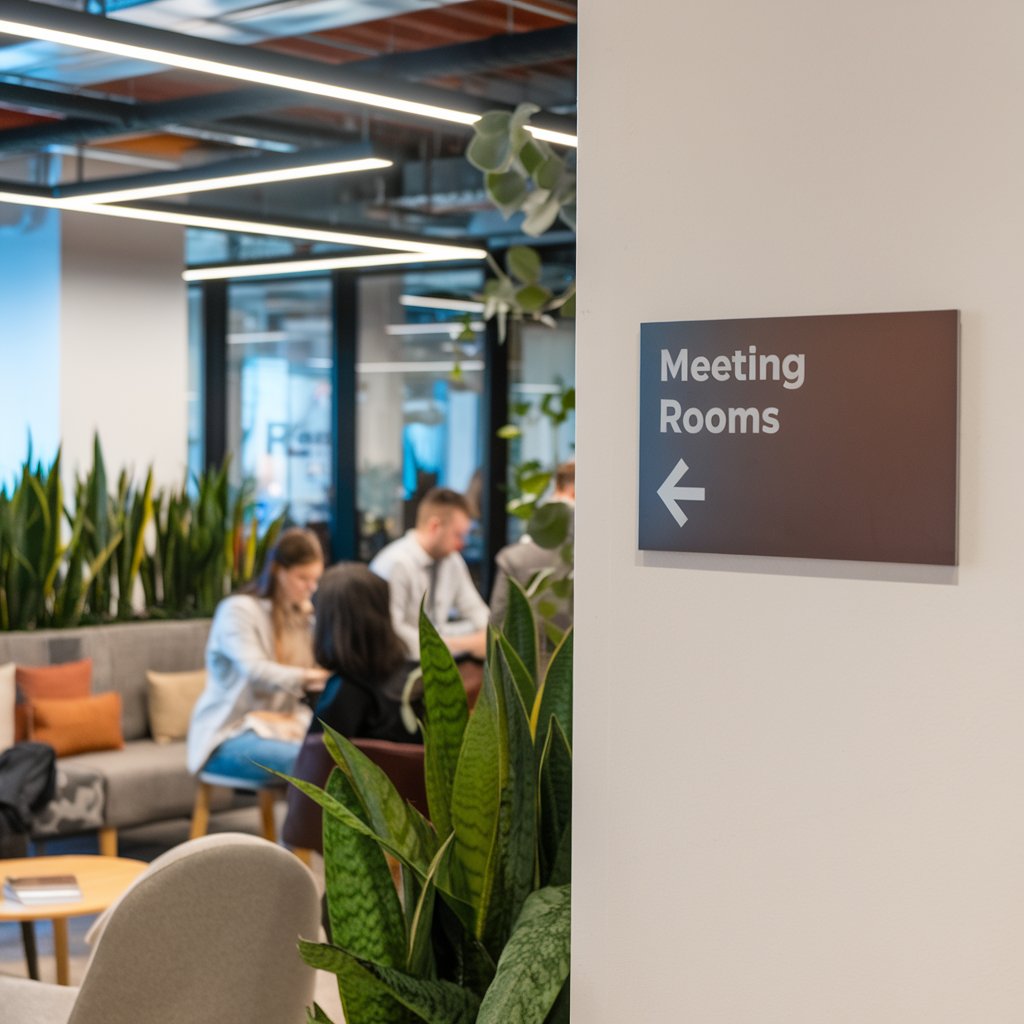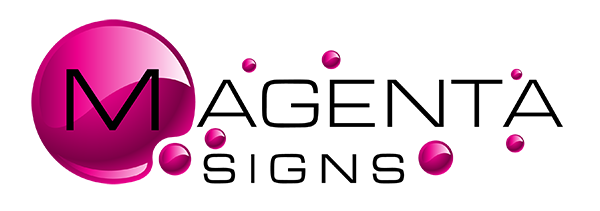Interior Wayfinding Signage: Improving Navigation With Clear Directional Signs
Interior wayfinding signage is vital for facilitating seamless navigation within buildings, utilising clear directional signs to reduce confusion and enhance the visitor experience. These systems employ strategic sign placement, high-contrast colours, and consistent brand integration to guarantee intuitive navigation. By guiding visitors efficiently to their destinations, wayfinding signage notably improves operational flow and user satisfaction. Consider exploring further for more insights into the essential elements that make these signs effective.
What Makes Internal Wayfinding Systems Effective?
Effective internal wayfinding systems utilise strategic colour and finish to guide clients and visitors smoothly through spaces.
These systems often incorporate elements of an organisation or team’s branding to create a cohesive visual experience.
Additionally, they are designed to assist first-time visitors in traversing unfamiliar environments efficiently.
Role of Colour and Finish in Wayfinding
The role of colour and finish in wayfinding systems is fundamental for enhancing navigational ease and user experience within interior spaces. Adequate wayfinding signage utilises a range of strategic colour contrasts and finishes to guide users efficiently.
For the visually impaired, high-contrast colours in signage are essential for visibility and orientation. The finish of interior wayfinding signage also plays a significant role; matte finishes reduce glare, essential under indoor lighting conditions.
Additionally, consistent use of colour aids in quick recognition and eases the cognitive load by associating specific hues with certain directions or actions. Integrating graphic design elements thoughtfully into directional signage ensures that all users can navigate spaces efficiently and safely, regardless of their visual abilities. For added visual support on floors, especially in high-traffic areas, consider incorporating floor sticker ideas to enhance your space, which can complement wall signage and reinforce direction cues effectively.
Integrating Branding with Wayfinding Signs
While colour and finish play significant roles in the functionality of wayfinding systems, integrating branding effectively elevates the functional utility and aesthetic coherence of signage. Incorporating corporate identity into internal wayfinding signage directs and enhances the visitor experience by making the environment more familiar and engaging.
When branding materials and wayfinding signs blend seamlessly, they convey information while promoting the organisation’s image. In environments such as retail spaces, integrating point-of-sale design tips into the wayfinding strategy can enhance both navigation and customer engagement at key transaction points.
Key aspects to reflect on include:
- Consistency: Use consistent logos, colour schemes, and fonts across all signage types to reinforce brand identity.
- Visibility: Ascertain that branding is visible but not overwhelming to maintain the primary function of the wayfinding sign system.
- Integration: Create internal signage that complements the interior decor, forming a cohesive visual environment aligned with corporate wayfinding strategies.
Adapting to Unfamiliar Environments with Ease
How do internal wayfinding systems facilitate navigation in unfamiliar environments?
Effective wayfinding within buildings, such as hospitals, universities, and office complexes, directs visitors efficiently. The strategic placement of internal wayfinding signs guarantees visitors can navigate spaces with minimal confusion and anxiety, considerably reducing stress.
A superior interior wayfinding system utilises clear, concise signage that communicates locations and directions straightforwardly. This approach not only aids in swiftly adapting visitors to unfamiliar environments but also enhances their overall experience by making navigation intuitive.
What are the Different Types of Internal Wayfinding Signage?
Interior wayfinding signage encompasses a variety of types, each one tailored to serving specific navigational purposes within buildings and retail locations.
Directional signs provide clear, concise guidance to visitors, essential in extensive facilities like hospitals or academic campuses.
Additionally, digital wayfinding solutions offer dynamic, interactive guidance that adapts to real-time environmental changes.

Understanding Directional Signs and Their Purpose
Understanding directional signs is essential for efficiently traversing through indoor spaces, as these signs guide visitors directly to their destinations without confusion.
Interior wayfinding signage encompasses various signs and sign systems to help individuals navigate complex environments. Here are the key types of internal wayfinding to create signage systems:
- Directional Signage: These signs point the way, showing directions and distances to different areas like restrooms, exits, and offices.
- Identification Signage: These signs label particular rooms or areas, such as conference rooms, departments, or service centres.
- Informational Signage: These signs provide additional details about the surroundings or building policies that could be vital for visitors to know as they find their way.
These navigational elements are integral in ensuring a smooth traffic flow within indoor spaces.
The Role of Internal Wayfinding Signs in Large Facilities
In expansive facilities like hospitals, universities, and corporate campuses, internal wayfinding signs play an essential role in ensuring that visitors and staff can navigate expansive and often complex environments effectively.
These signs enhance safety and accessibility by providing clear, concise directions to various departments and key areas. Internal wayfinding signage includes directional, informational message boards and identification signs. Each type is strategically placed to facilitate seamless navigation through corridors, lobbies, and intersections.
In airports, for example, such signage is critical for guiding passengers to their gates, baggage claims, and exits. By simplifying the process of finding destinations within extensive facilities, these signs markedly improve the experience of all users, reinforcing a sense of security and efficiency.
Exploring Digital Wayfinding Solutions
As technology advances, digital wayfinding solutions are increasingly integral to the internal navigation strategies of extensive facilities and organisations.
Digital wayfinding enhances seamless navigation and complements traditional signage systems, offering dynamic and interactive guidance.
Here are three principal types of digital wayfinding used in extensive facilities:
- Interactive Kiosks: These freestanding or wall-mounted units provide touch-screen interfaces, allowing users to search destinations and view detailed maps.
- Digital Signage: Strategically placed screens display maps, directions, and real-time updates, facilitating high-quality internal navigation.
- Mobile Applications: Apps integrate with a facility’s wayfinding systems, offering personalised route guidance directly on users’ devices, enhancing the benefits of wayfinding signage.
Expert wayfinding signage installation guarantees that wayfinding signs are custom-designed for peak user experience, leveraging the latest in digital technology.
How Does Directional Signage Enhance User Experience?
Directional signage enhances user experience by facilitating easy navigation through interior spaces.
By ensuring accessibility, such signage meets the needs of all users of construction sites, including those with disabilities.
Effective wayfinding significantly boosts visitor satisfaction by reducing confusion and increasing facility movement efficiency.
The Importance of Wayfinding Signage Design in User Navigation
Effective wayfinding signage design is essential for guiding users through physical spaces, enhancing their navigation and overall experience.
The design of clear directional signs within an interior setting is vital in improving navigation and ensuring seamless movement. Here are key aspects to reflect on:
- Functionality: Signs should convey information clearly and be positioned at strategic points to guide users efficiently.
- Design: The aesthetic should integrate with the environment while maintaining visibility and readability.
- Layout: A logical, intuitive placement of signs helps prevent confusion and reinforces a sense of orientation.
Ensuring Accessibility with Effective Wayfinding
Wayfinding signage must be designed with accessibility in mind to guarantee that everyone, regardless of ability, can navigate interior spaces effectively.
Accessible directional signs enhance navigation by providing clear, helpful information that caters to various needs. This includes features like Braille for visually impaired individuals and high-contrast colours for those with visual limitations.
In internal environments, such as hospitals or office buildings, ensuring that signs are easily readable and strategically positioned at key points aids in creating a seamless experience for all users.
This approach not only supports those with disabilities but also benefits healthcare facilities and the broader community by reducing confusion and improving the overall efficiency of movement within these spaces.
How Good Wayfinding Improves Visitor Satisfaction
Visitor satisfaction significantly improves when interior spaces are equipped with well-designed wayfinding signage. Clear, accessible directional signs facilitate seamless navigation, enhancing the user experience. The impact of adequate signage on visitor satisfaction is substantial:
- Reduces Stress: Visitors can navigate internal and external spaces without confusion, reducing anxiety and frustration.
- Increases Efficiency: Efficient navigation means visitors spend less time getting lost and more Time engaging with services or exhibits.
- Enhances Accessibility: Good wayfinding supports diverse needs, making spaces more inclusive for all users, including those with disabilities.
Implementing well-structured, clear signage not only streamlines the flow of traffic but also greatly boosts the satisfaction of visitors by improving their ability to move through spaces effortlessly.
What Are the Benefits of Wayfinding Signage in Office Environments?
Wayfinding signage in office environments dramatically enhances operational efficiency by boosting employee productivity; clear, strategic signs reduce the Time spent manoeuvring large or complex office spaces.
Additionally, well-designed wayfinding systems provide a seamless visitor experience, ensuring guests quickly locate their destinations without confusion.
These elements foster a more organised, welcoming office atmosphere conducive to business activities.
Boosting Employee Productivity with Effective Signage
How does effective wayfinding signage impact employee productivity in office environments? Well-structured and clear wayfinding signage in an office serves as a directional guide and greatly enhances workplace productivity.
Here’s how:
- Reduces Time Wasted: Employees spend less time traversing complex office layouts, allowing more time for productive work.
- Minimises Stress: Clear signage reduces the frustration and stress of getting lost or disoriented, fostering a more pleasant and efficient work environment.
- Enhances Safety: Effective signage helps quickly direct staff to exits or safety zones during emergencies, indirectly maintaining focus and reducing downtime.
Creating a Seamless Visitor Experience
Adequate wayfinding signage in office environments directs employees efficiently and plays a crucial role in creating a seamless visitor experience.
By deploying clear directional signs throughout the interior, visitors can navigate the space effortlessly, greatly enhancing their overall impression of the organisation. Such signs are key in improving navigation, preventing confusion and the potential stress of getting lost.
Moreover, well-designed wayfinding signage contributes to a professional atmosphere and can reflect positively on customers and the company’s brand.
Essentially, these navigation aids are indispensable for ensuring that every encounter within the business premises is smooth and positive, bolstering visitor satisfaction and fostering a welcoming environment.
How to Design and Install Effective Internal Wayfinding Signage?
Designing adequate internal wayfinding signage involves understanding key elements such as visibility, legibility, and informational hierarchy.
The installation process requires careful planning and execution to guarantee that signs and banners are strategically positioned and securely mounted.
Regular audits and updates should be integrated into the management practices to maintain consistency across the wayfinding system.

Key Elements of Wayfinding Signage Design
When creating internal wayfinding signage, it is vital to focus on clarity, visibility, and consistency. Key elements of design play a significant role in enhancing navigation and usability within interior spaces.
These elements guarantee that directional signs are informative and accessible to all users.
Key elements to take into account include:
- Legibility: Utilising clear, easy-to-read fonts and adequate contrast between text and background.
- Symbol Use: Incorporating universally recognised symbols that transcend language barriers.
- Strategic Placement: Positioning signs at decision points like entrances, hallways, and intersections to guide movements effectively.
These design principles are foundational in creating adequate wayfinding signage that facilitates smooth navigation and enhances the overall user experience.
Steps for Successful Sign Installation
To successfully implement interior wayfinding signage, the initial step involves meticulous planning of the design and installation process. It is vital to identify strategic locations within the building for placing signs, such as near elevators, in main hallways, or by emergency exits. This guarantees visibility and functionality.
| Step | Detail |
|---|---|
| Design Consideration | Verify signs like directories and suspended signs are clear and readable. |
| Location Selection | Choose high-visibility areas and intersections in the office. |
| Mounting Strategy | Decide on the method and hardware for secure installation. |
| Compliance Check | Verify adherence to building codes and accessibility standards. |
Effective installation enhances navigation, aiding in a smooth flow throughout the interior spaces, making them more accessible and user-friendly.
Maintaining Consistency in Wayfinding Systems
Ensuring uniformity in wayfinding systems is essential for minimising confusion and enhancing the user experience within any facility.
Maintaining consistency in interior wayfinding systems involves several pivotal steps:
- Standardise Sign Design: All directional signs should feature consistent fonts, colours, and symbols to reinforce clarity and improve navigation.
- Unified Placement Strategy: Signs should be strategically placed at consistent intervals and key decision points throughout the space to guide users effectively.
- Regular Updates and Audits: Continuously evaluate and update signs to reflect facility changes, ensuring that all navigation aids remain accurate and helpful.
Conclusion
Adequate internal wayfinding signage is vital for enhancing navigation within buildings. Organisations can significantly improve user experience by incorporating clear directional signs, ensuring visitors and employees find their destinations efficiently. Well-designed signage systems streamline movement and minimise confusion, contributing to a more organised and productive environment. When planning and installing these signs, attention to detail and user-focused design principles are essential for achieving ideal functionality and ease of use.


